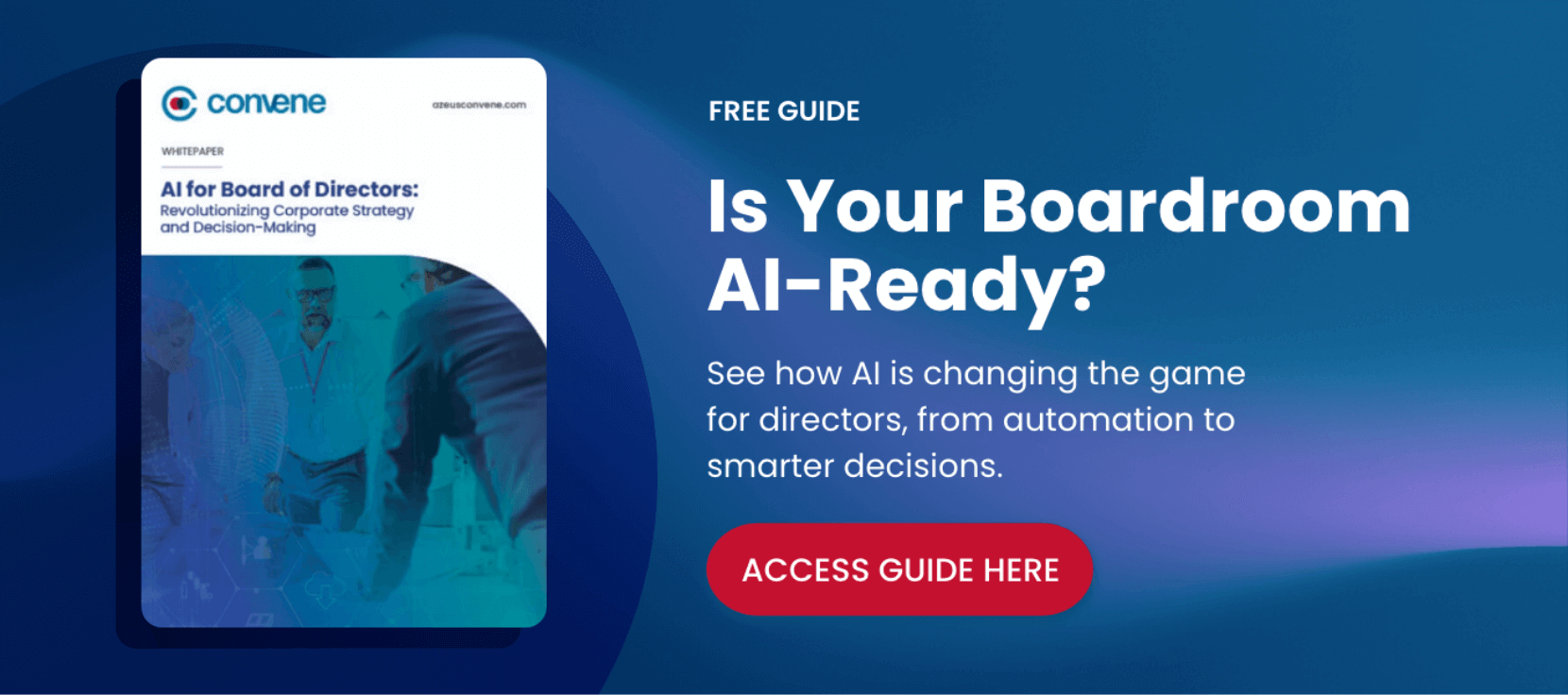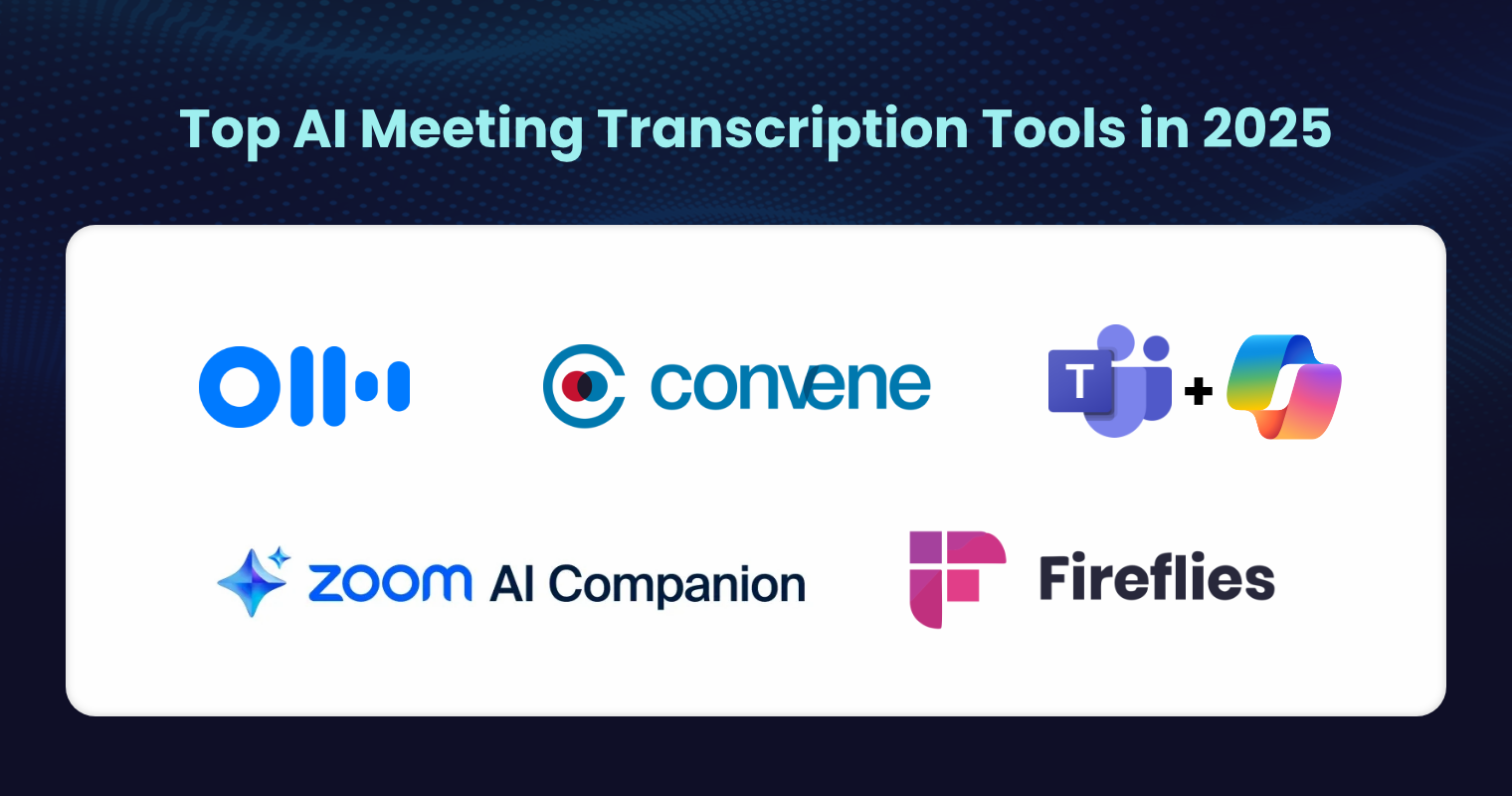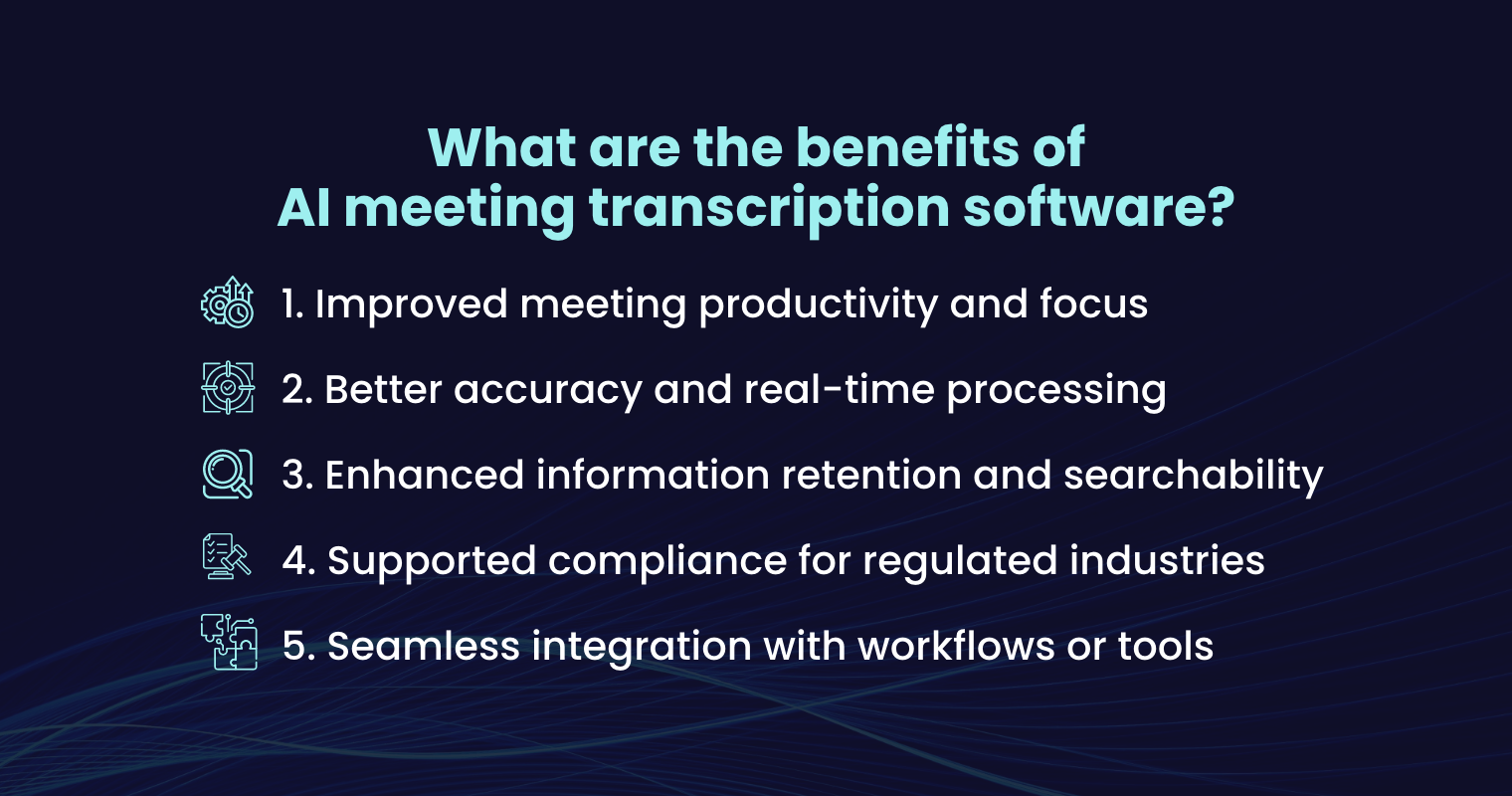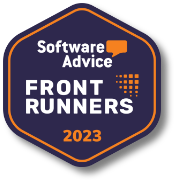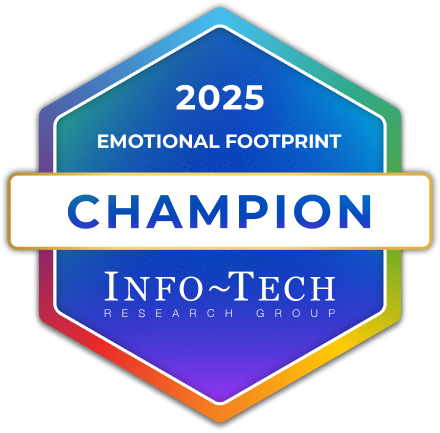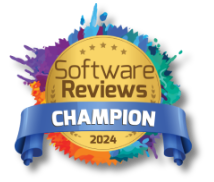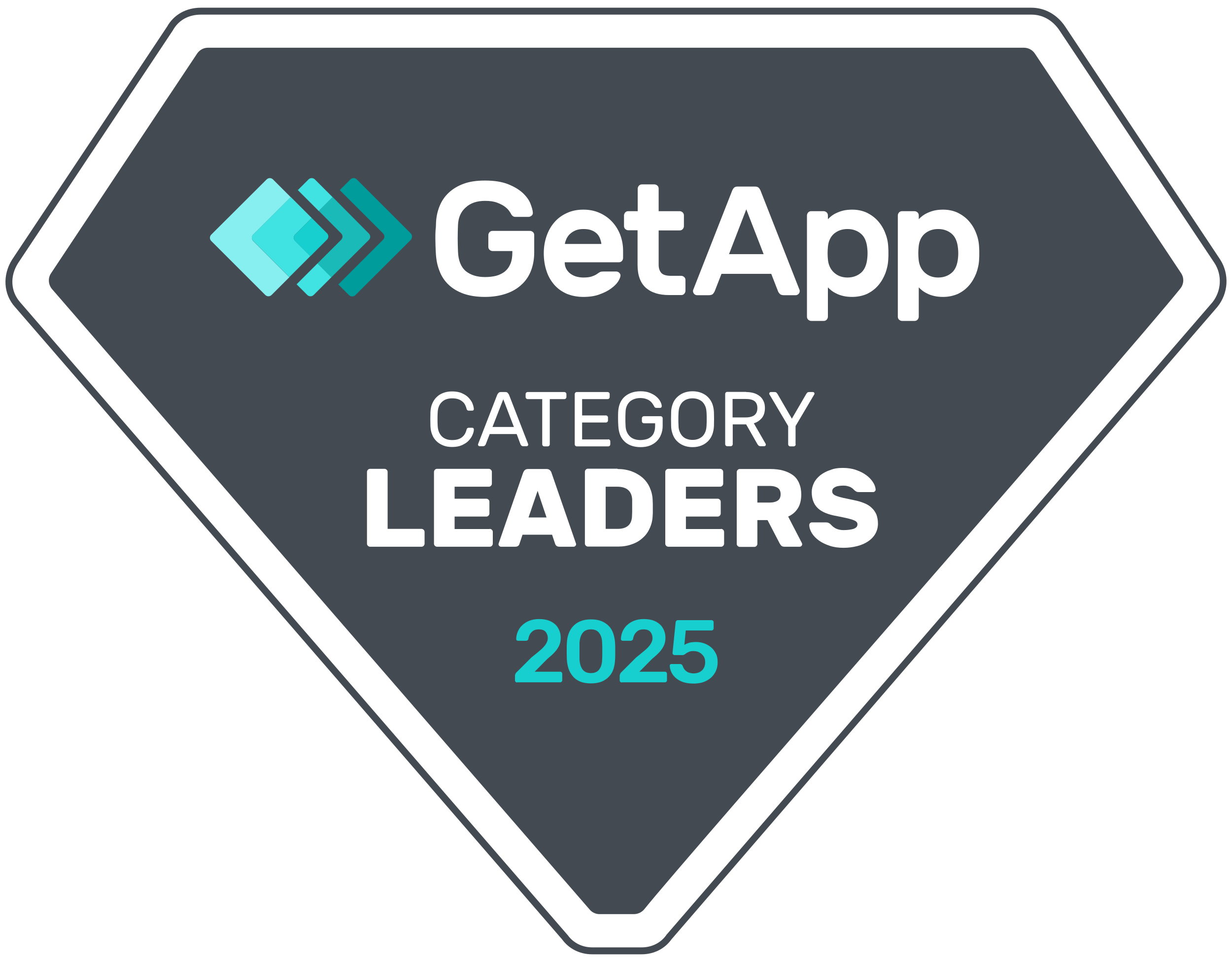The rise of artificial intelligence models is not only due to the need for better productivity or operational convenience. But also because of the evolving demands for accurate, real-time communication and documentation across distributed teams.
In 2025, AI meeting transcription has matured into a key component for various settings, including corporate enterprises, government bodies, the media industry, academic institutions, and even judicial courts. In the U.S. alone, the transcription market size was valued at $30.42 billion in 2024, and is predicted to grow at a CAGR of 5.32% from 2025 to 2030.
In order to help you learn about AI meeting transcription, we’ll delve into its meaning, features, benefits, and the best tools to consider.
What is AI meeting transcription?
AI meeting transcription is the automated process of converting spoken language from discussions (hybrid, virtual, or in-person) into written text using artificial intelligence technologies. This process leverages a confluence of subfields within AI, including machine learning (ML), natural language processing (NLP), automatic speech recognition (ASR), and even large language models (LLMs). Such systems are created to transcribe dialogue verbatim and contextualize or analyze one’s discussion.
In simpler terms, meeting transcription AI makes scribbling or taking meeting notes an easier task. It basically turns everything that people say into written text with the help of AI. Hit the record, and the AI does the rest. Some transcription tools even go a step further with features to highlight action items or sync the notes or reminders in a digital calendar.
AI Meeting Transcription vs. Manual Note-Taking
On average, AI meeting transcription apps can save up to 80-90% of time compared to manual note-taking. They are deemed to be a smarter, faster, and more accurate way to document conversations. See below how these AI transcription tools stack up against manual note-taking.
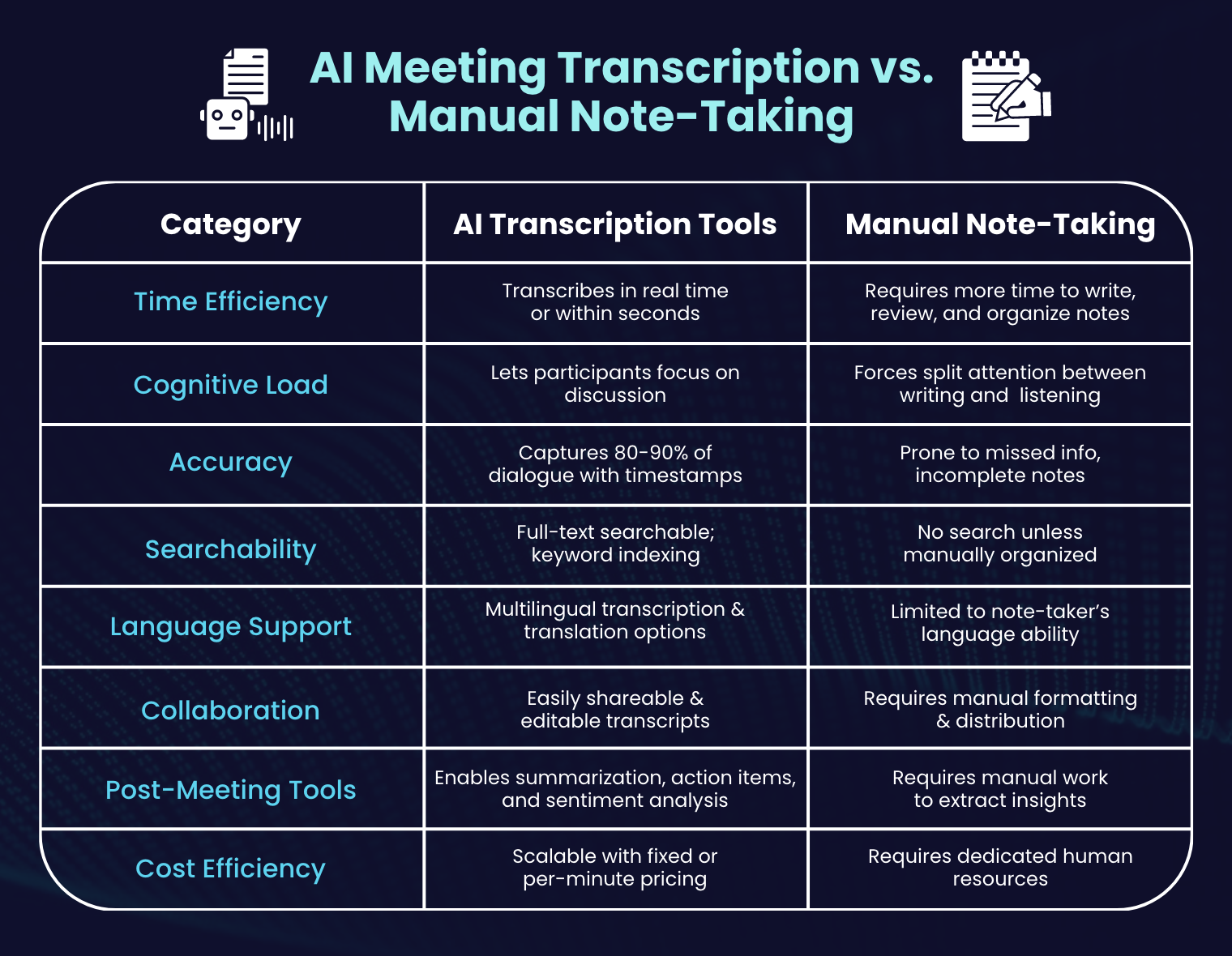
What features to look for in an AI meeting transcription tool?
Different AI meeting transcription apps offer different capabilities. Besides being voice-to-text converters, they are also multi-layered systems crafted to capture, process, and semantically interpret spoken communication in professional settings. Below are critical features that advanced AI transcription tools offer:
- Automatic Speech Recognition (ASR) Engine: Advanced transcription tools are often deemed as high-accuracy ASR engines based on deep learning models. Such models translate raw audio waveforms into structured word tokens while accounting for acoustic variability and ambient noise.
- Speaker Diarization: Most tools can identify and separate speakers within a conversation without prior settings or training. This feature is beneficial in multi-participant settings like board meetings or legal depositions. In some systems, diarization is linked to user profiles in enterprise Single Sign-On (SSO) systems, allowing speaker tagging.
- Custom Vocabulary and Domain Adaptation: Meeting transcription AI tools usually allow users to upload custom dictionaries or language models for domain-specific jargon (e.g., legal terms, medical abbreviations, brand or product names).
- Summarization and Insight Generation: Most advanced tools integrate LLMs to go beyond mere transcriptions. Hence, enabling them to offer meeting summarization, topic modeling or clustering, contextual redaction of sensitive content, and question answering within the transcript.
- Multilingual and Code-Switching Support: Some AI transcription tools support different languages and dialects, and even handle code-switching (the process of alternating between two or more languages).
- Security and Compliance: Enterprise-grade transcription tools are typically required to meet certain compliance frameworks like FedRAMP (for U.S. government cloud systems), SOC 2 Type II, GDPR (for EU data subjects), and HIPAA (for healthcare).
Top AI Meeting Transcription Tools in 2025
There are numerous tools available in the market today, and choosing the right one that suits your needs can be daunting. Here’s a list of the best meeting transcription software to help with your search.
1. Convene with Convene AI
Convene’s purpose-built AI capability that offers secure, end-to-end transcription, meeting summarization, decision and action tracking, and board workflow automation. It enables the automatic generation of action items from meeting minutes, with the option to refine or edit the summaries as needed. Powered by AWS Bedrock, Convene AI ensures enterprise-grade data protection and governance compliance.
Pricing:
- Pricing model is on a per–user license, per-year basis
Customized pricing is also available
Best for:
- Corporate boards, executive committees, and governance-heavy organizations.
- Administrators seeking minute-taking automation, decision-tracking, and governance reporting.
2. Otter.ai
Known as one of the leading AI transcription tools, Otter.ai uses a proprietary Automatic Speech Recognition (ASR) pipeline for speech recognition and diarization techniques for speaker identification. It is a popular choice for those who need searchable meeting records, with features ranging from real-time transcription, outline creation, and action items generation.
Pricing:
- Free plan is 300 transcription minutes per month
- Pro plan is $16.99 a month with 1,200 transcription minutes and advanced export
- Business plan is $30 per user per month with 6,000 transcription minutes and unlimited import
Best for:
- Academic researchers, content creators, and small-to-mid teams that require quick and sharable meeting notes.
3. Microsoft Teams with Copilot (Microsoft 365)
With ASR powered by Azure Cognitive Services, Microsoft Teams provides native transcription enhanced by Copilot. It features semantic summarization, task extraction, and sentiment analysis in the post-meeting workflow. This is also fully integrated within Microsoft’s productivity ecosystem.
Pricing:
- Teams meeting transcription is included in Microsoft 365 Business Standard
- Copilot Add-on: $30 per user per month (enterprise license only)
Best for:
- Organizations deeply embedded in the Microsoft 365 ecosystem, and require data residency and identity management controls.
4. Zoom AI Companion
Made to improve Zoom meeting experience, Zoom AI Companion uses a hybrid model for audio processing (Zoom’s ASR engine) and relies on GPT-based LLMs for semantic understanding and summarization.
Pricing:
- Included in Zoom Pro, Business, and Enterprise plans
No additional cost for AI Companion (as of 2025)
Best for:
- Organizations already using Zoom as primary communication platform.
5. Fireflies.ai
Initially built on Mozilla DeepSpeech, Fireflies.ai now leverages OpenAI Whisper combined with proprietary NLP layers for workflow automation. It focuses on automated meeting capture, topic tagging, and CRM integrations.
Pricing:
- Free 800 minutes of storage
- Pro is $10 per user per month with 8,000 minutes of storage
- Business plan is $19 per user per month with unlimited minutes storage
Best for:
- Sales and product teams that require meeting documentation with CRM automation.
*All prices mentioned are subject to change without notice, and may vary based on provider discounts or promotions.
What are the benefits of AI meeting transcription software?
Both individuals and businesses find AI transcription tools beneficial for upgrading their workflows. And its benefits even go beyond simple speech-to-text conversion. Find out what these benefits are below:
1. Improved meeting productivity and focus
Manual note-taking is an everyday hassle in many workplaces, often impeding participants from staying engaged in a discussion. But with AI transcription tools, taking meeting minutes or notes is one task ticked off the to-do list. They minimize the need for manual note-taking and post-meeting documentation, or even completely eliminate it.
NLP models, for example, can automatically generate meeting summaries, action items, and key decisions. Therefore, reducing administrative overhead and enabling individuals to focus on the current meeting. In Microsoft’s 2024 Work Trend Index Annual Report, 90% of surveyed users said AI helps them save time and 85% said it allows them to focus on their most important work.
2. Better accuracy and real-time processing
Modern AI transcription engines use ASR and NLP to not just automate documentation but also improve accuracy. The complete accuracy of these AI tools, however, still depends on factors like audio quality, background noise, and speaker accents across different clinical settings.
Some AI systems (e.g., Otter.ai) utilize speaker diarization and context-aware models to identify multiple speakers. Integrated AI tools in videoconferencing platforms also prove to be valuable, with Zoom leading with 99.05% accuracy while Webex comes in at 98.71%. The transcript quality of Zoom is also reported to have 27% fewer errors compared to Webex.
Using AI transcription tools in real time enables participants to view live captions during the meeting. Remote or hard-of-hearing users can also then follow along synchronously, ensuring participation from all attendees.
3. Enhanced information retention and searchability
Meeting transcripts can serve as significant, searchable records of critical corporate discussions. They can be indexed, tagged, and linked to other documents or workflows using NLP techniques, such as named entity recognition (NER), topic modeling, and summarization.
In other words, AI transcriptions allow for keyword-based search and tagging that can turn those ephemeral conversations into indexed, permanent records. One example is Notion AI’s transcription integration, which supports semantic search wherein users can locate discussions even when the exact phrasing is unknown. This means that a user searching for “budget concerns” might come across relevant information, such as cost overruns or funding issues.
4. Supported compliance for regulated industries
In sectors like legal, finance, and healthcare, it is a regulatory necessity to maintain an accurate record of meetings. AI transcription tools can support this compliance need by generating auditable, time-stamped logs of conversations. For better compliance, some firms even combine them with data encryption and access control features.
Moreover, AI transcription systems can be configured to meet major frameworks like HIPAA (Health Insurance Portability and Accountability Act), FINRA (Financial Industry Regulatory Authority), and GDPR. This allows them to comply with how confidential and personal information is captured, stored, transmitted, and accessed. Other AI tools can even redact sensitive data or flag risks through NER and custom classification models.
5. Seamless integration with workflows or tools
Another great thing about AI transcription tools is their ability to integrate with enterprise workflow and project management platforms. This turns the transcripts from static records into actionable assets within a broader digital ecosystem.
For instance, a transcript generated by the best meeting transcription software like Otter.ai or Fireflies.ai can extract key phrases and automatically convert them into tasks within a team’s project management tool. As for high-level governance use, board management platforms like Convene are embedding AI transcription capabilities to streamline board workflows.
Future Trends in AI Meeting Transcription: Deep Learning, Gen AI, and Multimodal
As artificial intelligence advances, the way organizations convert speech into text is evolving rapidly. Read on to find out the future trends in meeting transcription AI.
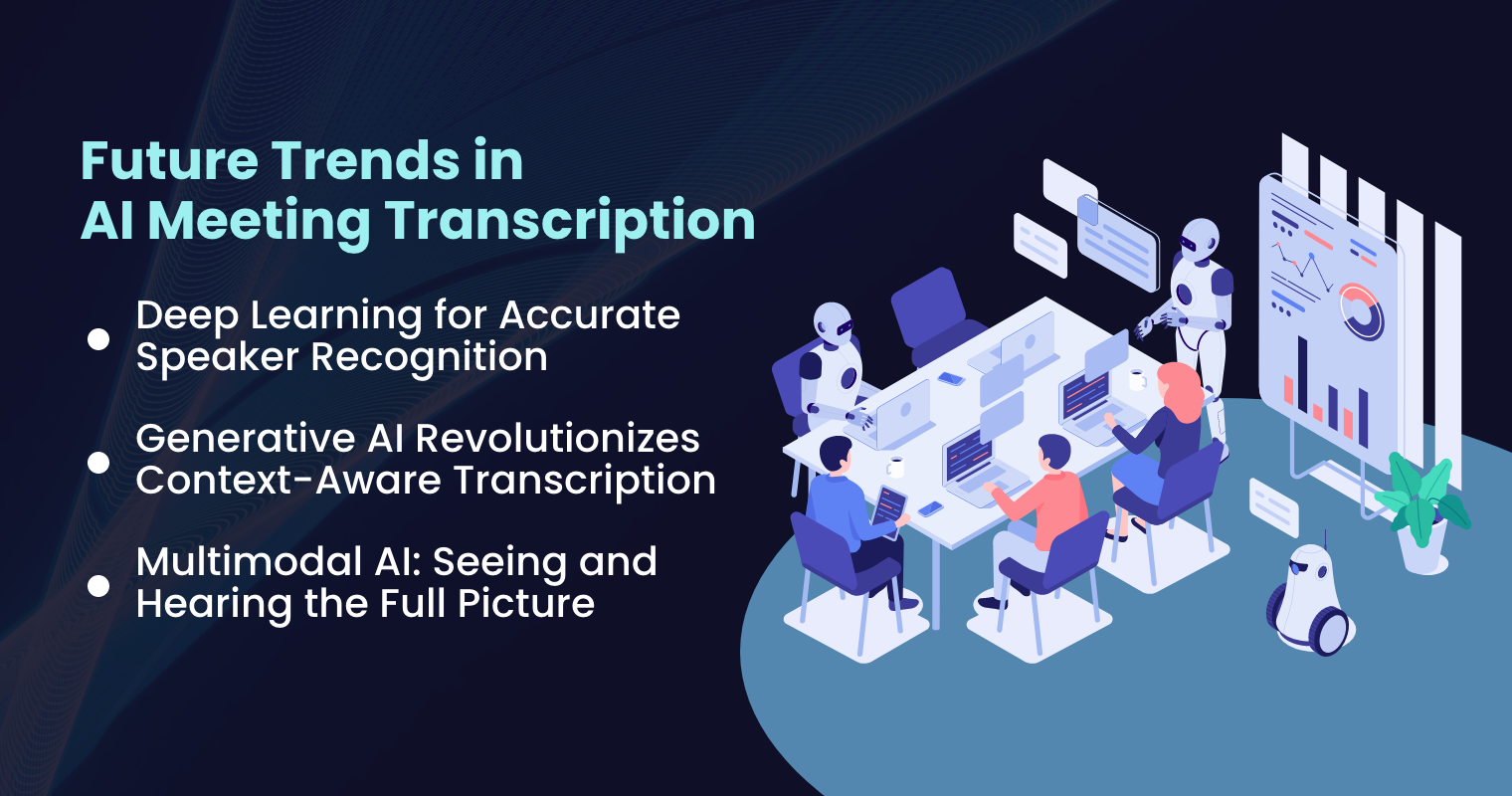
1. Deep Learning for Accurate Speaker Recognition
Speaker identification (SI) and verification (SV) stretches to be critical components in speech technology. Deep learning (DL) has infiltrated this field since its earliest developments, with methods being applied in SI and SV tasks.
Deep learning methods are predicted to be continually used in speaker recognition in two major directions. First is to replace the i-vector mechanism, which is a compact representation or “fingerprint” of one’s voice, and extract a unique, DL-generated voice fingerprint. The second one is using it for direct voice classification. After the voice characteristics extraction, a DL network will identify who the speaker is, or acts as a “judge” when distinguishing between speakers.
2. Generative AI Revolutionizes Context-Aware Transcription
Known as a subset of AI, Generative AI primarily focuses on creating data instead of just analyzing it. Such systems, using deep learning techniques like GANs and VAEs, can generate new, human-like content autonomously. The forms of content it can produce include written, audio, image, video, and coded materials.
Poised to expand even further, Generative AI is expected to become a “general-purpose technology” and even make its way into various creative fields like art, writing, and music. Overall, Generative AI continues to go beyond basic speech-to-text by providing smart, context-aware transcription.
3. Multimodal AI: Seeing and Hearing the Full Picture
Multimodal AI sets up the next frontier in AI transcription by integrating different data forms, such as text, audio, and image, simultaneously. Unlike traditional AI which handles a single type of data, multimodal AI processes information from multiple modalities or data sources. It incorporates visual cues like facial expressions and gestures, and cross-references tone of voice and word choice for better analysis.
Major AI players such as Meta, OpenAI, and Google DeepMind are also investing in the development of these systems. With significant advancements underway, multimodal AI is expected to provide more accurate sentiment analysis by combining auditory and visual data.
Frequently Asked Questions About AI Meeting Transcription
Is AI transcription legal?
While generally legal, AI transcription is governed by data privacy and wiretapping laws that vary by jurisdiction. In one-party states or countries, only one participant needs to consent to recording and transcribing. In two-party (or all-party) consent jurisdictions, every participant must give explicit permission. Failing to obtain proper consent can lead to legal issues.
Is there a free transcription AI?
Yes, several AI transcription tools offer free versions, but they often come with usage limits or feature restrictions. Some of these include:
- Otter.ai Free Plan: Limited transcription minutes per month.
- Google Meet Live Captions: Real-time captions, but no saved transcriptions.
- OpenAI Whisper (open-source): Free to use locally but requires computational resources (GPU/CPU).
Can AI transcription handle overlapping speech?
Yes. AI transcription can process overlapping speech using speech separation (source separation) techniques and speaker diarization models, which attempt to distinguish simultaneous voices. Still, handling crosstalk remains technically challenging, especially when speakers’ voices overlap significantly or in noise environments.
What audio formats are supported by AI transcription tools?
Most AI transcription engines support a variety of audio and even video formats, including:
- Audio: WAV (lossless, preferred for high accuracy),MP3 (compressed), M4A (AAC codec), FLAC (lossless).
- Video: MP4, MOV, MKV (audio track extracted for transcription).
Convene: Empowering Boardrooms with Smarter, More Secure AI Transcription
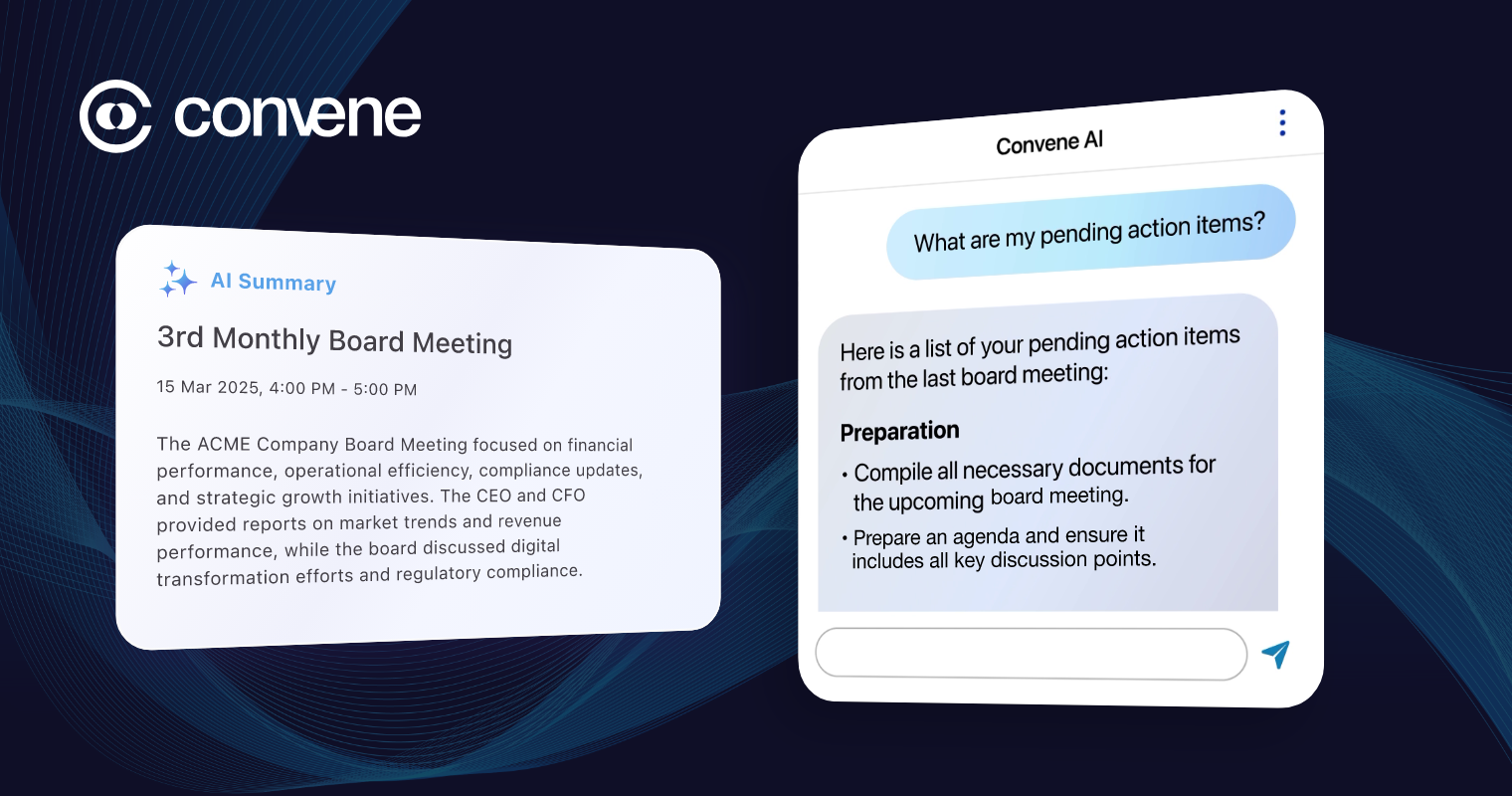
As artificial intelligence advances, concerns around its ethical use, inconsistent results, and especially, data privacy continue to grow. Some boards today are still hesitant to fully adopt AI meeting transcription software despite its potential for improved productivity and workflows.
Convene, a leading board management software, has introduced a new, game-changing feature, Convene AI. Launched as part of Convene’s version 9.0 release, this next-generation feature offers an end-to-end AI experience paired with enterprise-grade security to ensure data protection.
Built on AWS Bedrock, Convene AI ensures industry-leading data protection and compliance, and a commitment to the ethical use of AI. With Convene AI, users can have access to:
- Meeting Summary and Insights: Automatically generate meeting summaries, key decisions, and timelines, with full transcripts available.
- Automated Action Tracking: Convert suggested action items into formal ones, and assign owners and deadlines.
- Intelligent AI Assistant: Simplify workflows with Convene AI’s app and action assistant, allowing users to get direct access to customer support or retrieve past actions and decisions on their behalf.
Curious about Convene AI? Contact our team today to learn more.
Jielynne is a Content Marketing Writer at Convene. With over six years of professional writing experience, she has worked with several SEO and digital marketing agencies, both local and international. She strives in crafting clear marketing copies and creative content for various platforms of Convene, such as the website and social media. Jielynne displays a decided lack of knowledge about football and calculus, but proudly aces in literary arts and corporate governance.


